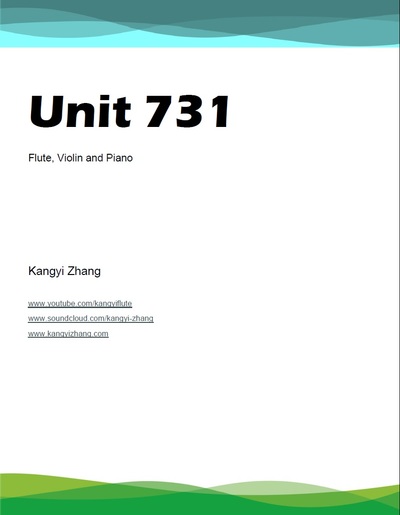Unit 731 (flute, violin and piano) in 4 movements
$20.00
Description
During WWII, Unit 731 was a covert biological and chemical warfare research unit of the Imperial Japanese Army, located in Harbin, China. Together with affiliated units throughout Asia, these units saw the most horrendous prisoner experiments conducted in a systematic manner.
1. Fear
Under the watchful eyes of the Japanese troops, the prisoners alight from the trains and enter the gates. No one dares to catch a glimpse of the soldiers. Beginning with the piano and then all instruments, bolts of notes strike through the texture to represent intimidation and the hitting of the prisoners.
Towards the end of the movement, the pianist plucks out a fragment of a melody which will be the opening sounds for the violin in the second movement. The movement ends with the closing of the gate - the sealing of the fate of these prisoners.
2. Pain
A victim is led from the prison cell to the experiment room. Key clicks and bow flicks mark the point when the victim finally arrives. His heartbeat races as he is being tied onto a table. A knife enters. He screams, writhes in pain and constantly scratches the table with his fingernails.
Chemical tests were done in gas chambers and when the war ended, all the remaining prisoners were gassed. The soldiers (musicians) shout ‘3,2,1’ in Japanese to mark the start of the gassing process. The section ends with the collapse of the victims, marked by a heavy piano chord. The final section depicts the last moments of all these victims. Coughing and blood dripping sounds are heard above the violin melodic fragment which started the movement.
3. Remorse and Sorrow
My first inspiration for this movement came from Penderecki’s Prelude for clarinet solo. After 60 years, Yoshio Shinozuka returns to the site of his crimes. Against harsh criticism from his peers, he testified the horrific events as the Chinese families sued the Japanese government for compensation. The piece begins with the violin and the flute playing melodies based on two scales which are half-step apart (B and Bb). This half step relationship will serve as a fundamental material for the entire movement.
Later, the piano recalls the same plucking tune heard in the first movement, but with some variation. As Shinozuka walks the complex, familiar scenes create reflections just like the reverberations of the piano strings caused by the flute and violin.
4. Hope
During the war, ceramic shells with fleas were dropped randomly onto surrounding villages to spread the bubonic plague. After the war, Unit 731 released thousands of infected rats that caused widespread plague in 22 counties of Heilongjiang and Jilin provinces.
This movement is in 3 sections. ‘The survivors overcome grief and loss’ - The first three notes G-D#-C represent Unit 731. Other units which are represented are: 8604 (Guangzhou), 1855 (Beijing), 9420 (Singapore) and 1644 (Nanjing). ‘The survivors congregate for hope and peace’ - Disparate melodic lines eventually come together with the flute and violin playing in unison. Here, I see the survivors gathering to spread an important unified message to the world. ‘The museum retains fragments of memories for future generations’ - Previous materials return and generate a feeling of everlasting impact.
SHARE THIS









